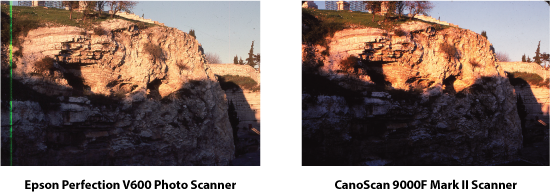Last week, I wrote about my brand new Epson Perfection V600 Photo scanner. My frustrations were short lived, however, because I returned the unit. Buh-bye!
It was difficult to find a replacement. Scanners aren’t a high-priority peripheral. Plenty of cheap scanners are available, which do the occasional job just great. Then you take a tremendous leap to high-end scanners, which offer document feeders and other professional-level features. Between the two is dry ground.
As I searched for a replacement, I kept in mind the features that I wanted. Specially, I need to scan transparencies. I wanted a flatbed scanner. My price range was between $100 and $200. Below $100 you find low-end scanners. Beyond $200, high-end scanners kick in, with most going for $500 or more.
Ironically, every search result suggested that the most perfect scanner for me was the Epson Perfection V600, the device I just returned.
After a few more frustrating days, I came upon the Canon CanoScan 9000F Mark II.
OMG. This is the scanner I should have purchased in the first place.
As with the V600, the 9000F features quick buttons. And just like the Epson, the buttons don’t work on my Mac. So I must use the companion program, which is really stark. It doesn’t really give you much control of what’s scanned; a single “Auto” setting pretty much covers everything.
To test the device, I scanned a document and a transparency. The results were on a par with the Epson, but the CanoScan was tremendously faster, about 4 times quicker is my guess. I was blown away!
Figure 1 illustrates the final scan I took with the Epson V600 side-by-side with the CanoScan 9000F’s scan of the same transparency.

Figure 1. See the ugly green line on the left slide? That’s why I returned the Epson scanner and obtained the Canon scanner.
For more money, I’m sure a high-end scanner would let me adjust the color values and more properly crop the transparency. Still, I can do that in Photoshop, so the subtle differences between the two images in Figure 1 are okay, aside from the ugly green streak, of cousre.
For speed and accuracy, I’m most pleased with the CanoScan 9000F. Now if I need to write yet another blog post on my seventh scanner, I will be grossly disappointed.


My scanner is a Cannon Lide25 which was bought for two reasons it was cheap & USB…never had an issue with it. I use a bit of software I tend to use once I have is Gimp.
Comment by glennp — December 6, 2016 @ 11:21 am
I’d be completely happy with a low-end scanner. I don’t really scan that much, but recently I embarked upon several major scanning projects. So my tolerance has increased.
Comment by admin — December 6, 2016 @ 11:26 am